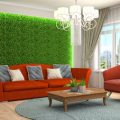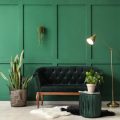Introduction to Biophilic Design
Biophilic design is more than a trend—it’s a philosophy rooted in our innate connection to nature. As American interiors evolve, this approach has become increasingly influential, weaving organic textures and natural elements into the fabric of everyday spaces. By integrating biophilic principles, designers aim to create environments that are not only visually appealing but also promote well-being and comfort. In a world where urban living often disconnects us from the outdoors, biophilic design seeks to restore that lost harmony. This movement is redefining what it means to feel at home, inviting the outside in and blurring the boundaries between nature and the built environment.
Embracing Nature Indoors
Biophilic design invites us to blur the boundaries between indoor and outdoor spaces. By incorporating living elements and organic materials, we create environments that feel fresh, alive, and deeply human. Bringing nature inside isn’t just about aesthetics—it’s about fostering well-being and creating restorative spaces where we can truly thrive.
Living Walls & Houseplants
One of the most impactful ways to embrace biophilia is with living walls—vertical gardens that transform plain surfaces into lush ecosystems. Houseplants, from sculptural fiddle leaf figs to trailing pothos, offer flexibility for any space or style. These green companions purify the air and bring a calming presence, making them essential in both homes and offices.
Raw Materials for Authenticity
The textures of nature—untreated wood, natural stone, woven fibers—ground interiors in authenticity. Raw materials not only add tactile richness but also evoke a sense of place and timelessness. Consider exposed beams, reclaimed wood accents, or linen upholstery to enhance sensory experience and connect with the outdoors on a deeper level.
Ways to Bring Nature Indoors
| Element | How It Nourishes Well-being |
|---|---|
| Living Walls | Improves air quality, reduces stress, boosts creativity |
| Houseplants | Purifies air, enhances mood, adds visual interest |
| Raw Wood Furniture | Brings warmth, connects to nature’s textures |
| Natural Stone Accents | Adds grounding energy, timeless appeal |
Integrating these elements isn’t just a trend—it’s a lifestyle shift. Biophilic design reminds us that by embracing nature indoors, we cultivate spaces that nurture our senses and elevate our everyday living.

3. Celebrating Organic Textures
Organic textures are the heartbeat of biophilic design, bringing a tactile and visual richness that transforms interiors into sanctuaries. Elements like wood, stone, and natural fibers do more than just look good—they engage our senses on a deeper level. The grain of reclaimed oak flooring, the cool touch of river stones, or the softness of woven jute infuse rooms with warmth and authenticity.
Wood: Nature’s Timeless Statement
In American interiors, wood is more than a material; it’s a connection to nature’s legacy. From walnut cabinetry to exposed ceiling beams, wood introduces depth, pattern, and a sense of grounding. Each knot and imperfection tells a story, making every space feel unique and welcoming.
Stone: The Art of Earthiness
Stone surfaces—whether sleek marble countertops or rugged slate accent walls—add layers of character. Their coolness under hand and subtle variations in color evoke the outdoors, reminding us of mountain trails and riverbeds. Stone balances modern minimalism with an enduring sense of stability.
Natural Fibers: Texture Meets Tranquility
Baskets woven from seagrass, linen upholstery, or chunky wool throws soften spaces visually and acoustically. These organic fibers create peaceful retreats that invite relaxation, echoing the calming rhythms found in nature. They’re practical too—breathable, durable, and always in style.
Sensory-Rich Interiors
Biophilic design thrives on sensory experience. By layering organic textures throughout your home—from floors to ceilings—you cultivate environments that soothe the mind and elevate everyday living. It’s about celebrating nature’s artistry in ways that feel fresh, authentic, and unmistakably American.
4. Biophilic Design and Modern Lifestyles
As American lifestyles evolve, biophilic design emerges as more than just an aesthetic trend—it becomes a pathway to healthier, more balanced living. The shift toward remote work, increased urbanization, and a growing focus on personal wellness all intersect with the core principles of biophilic design. By integrating organic textures and natural elements into our interiors, we create environments that nurture both productivity and well-being.
Work-from-Home: Nature Meets Productivity
Remote work is now a staple for many Americans. Biophilic design transforms home offices by introducing elements like live plants, wood grains, or daylight-inspired lighting, which can reduce stress and enhance focus. Consider how these features directly impact daily routines:
| Biophilic Element | Work-from-Home Benefit |
|---|---|
| Natural Light | Boosts mood and productivity |
| Indoor Plants | Improves air quality, reduces fatigue |
| Organic Materials (wood, stone) | Creates calming, tactile environments |
Urban Living: Bringing the Outdoors In
Cities are vibrant but often lack direct access to nature. Through biophilic design, urban apartments can feel more open and grounded. Textured wall panels, green walls, and earthy color palettes help bridge the gap between concrete landscapes and organic calm—making small spaces feel expansive and nurturing.
Personal Wellness: Designing for Mindful Living
The American wellness movement emphasizes self-care at home. Spaces that incorporate biophilic principles—like textured rugs reminiscent of forest floors or bathrooms echoing spa-like tranquility—support relaxation and mental clarity. Even in high-traffic areas like kitchens or entryways, subtle organic touches invite mindfulness into everyday rituals.
How Biophilic Design Supports Modern American Lifestyles
| Lifestyle Trend | Biophilic Solution |
|---|---|
| Remote Work | Nature-inspired desk setups; visual access to greenery |
| Urban Living | Vertical gardens; natural materials in compact spaces |
| Wellness Focus | Sensory-rich textures; calming color schemes; connection to outdoor views |
Design Philosophy: Harmony in Everyday Life
Biophilic design isn’t about replicating nature exactly—it’s about fostering harmony between our built environments and our innate desire for connection with the natural world. In today’s fast-paced American lifestyle, these organic textures become daily reminders to pause, breathe, and find balance—whether you’re on a Zoom call or unwinding after a busy day.
5. Sustainable Sourcing & Eco-Conscious Choices
In biophilic design, sustainability isn’t just a trend—it’s a philosophy that shapes every decision. Selecting sustainable materials and décor is central to creating interiors that honor both nature and American green values. Start with locally sourced woods, reclaimed lumber, or FSC-certified timber for furniture and finishes. These choices reduce transportation emissions and support local economies, reflecting the American spirit of community and environmental stewardship.
Consider textiles made from organic cotton, hemp, or recycled fibers. These options minimize chemical use and water waste, aligning with eco-conscious living. When choosing décor, seek out artisans who use natural dyes and traditional techniques, ensuring each piece has a story rooted in authenticity and care for the planet.
Transparency is key: look for brands that provide clear information about their sourcing practices. Certifications like GREENGUARD or Cradle to Cradle help guarantee that products are non-toxic and environmentally responsible. In America’s diverse landscape, supporting indigenous makers or small-scale craftspeople adds another layer of meaning, connecting interiors to broader narratives of culture and conservation.
Sustainable lighting—such as LED fixtures or fixtures crafted from recycled materials—can further enhance energy efficiency while maintaining style. Even plant choices matter: opt for native species or plants grown by local nurseries, promoting biodiversity and reducing invasive risks.
The result? Spaces that feel fresh, ethical, and deeply connected to both place and purpose—a true reflection of modern American values in interior design.
6. Design Tips for Effortless Integration
Start Small: Green Accents Make a Big Difference
If you’re new to biophilic design, begin with simple touches. A cluster of potted plants on a kitchen windowsill or a statement fiddle leaf fig in the living room can instantly add organic life and energy. Choose low-maintenance varieties like snake plants or pothos for easy upkeep—ideal for busy American lifestyles.
Play with Natural Materials and Textures
Incorporate wood, stone, bamboo, or rattan into your furniture and décor. Think reclaimed wood coffee tables, woven baskets for storage, or linen throw pillows that add tactile interest. These elements ground your space, bringing the outdoors in while maintaining a modern, stylish feel.
Let the Light In
Maximize natural light by using sheer curtains or strategically placing mirrors to reflect sunlight deeper into your space. Daylight not only supports plant growth but also boosts mood and productivity—a win-win for home offices or family rooms.
Create Organic Flow with Layout
Arrange furniture to encourage movement and sightlines toward windows or greenery. Curved edges and asymmetrical arrangements echo nature’s forms, making interiors feel more relaxed and welcoming.
Layer in Nature-Inspired Art and Accessories
Select artwork featuring landscapes, botanical prints, or abstract interpretations of natural patterns. Complement these with textured rugs and ceramics in earthy tones to reinforce the biophilic narrative without overwhelming your space.
Stay Practical: Balance Beauty with Function
Choose pieces that serve dual purposes—think plant stands that double as side tables or modular shelving that showcases both books and greenery. This ensures your space stays clutter-free while celebrating organic elements in everyday life.
The essence of effortless biophilic design is weaving these features into your daily routine so they feel like a natural extension of your lifestyle—inviting, inspiring, and uniquely yours.
7. Conclusion: The Future of Biophilic Interiors
Biophilic design has evolved from a trend to a transformative movement, reshaping how Americans approach their living and working environments. By integrating organic textures, natural light, and greenery, interiors now foster well-being, creativity, and a connection to nature—even in the heart of the city. As sustainability and wellness continue to drive design choices, biophilic principles are set to become foundational in both residential and commercial spaces. Looking forward, we’ll see smarter use of sustainable materials, adaptive lighting systems that mimic natural rhythms, and more seamless integration of indoor-outdoor experiences. These innovations promise not only healthier spaces but also greater harmony with the environment. In essence, the future of American interiors is rooted in nature—timeless, restorative, and always evolving.


